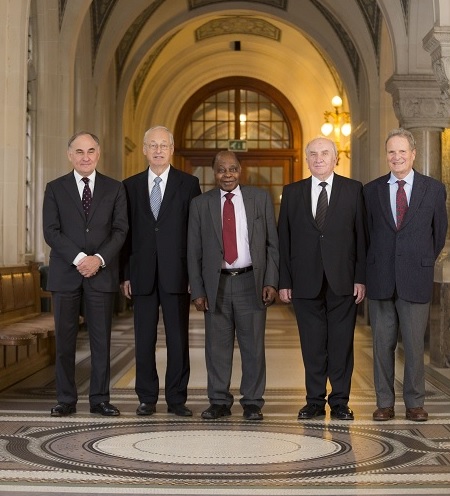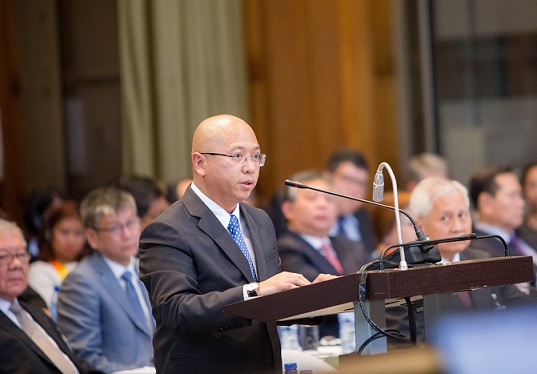
By Romel Regalado Bagares
And so the Philippines has just had its Nicaraguan moment as it clinched a unanimous decision in most of its 15 arbitral claims against Chinese “Nine-Dash Line” expansionism in the South China Sea.
The Permanent Court of Arbitration, in a landmark ruling released July 12 on the case In the Matter of the South China Sea Arbitration (it’s formal name, also referred to here as the Philippine Case), invalidated China’s claims over pretty much of the maritime areas in the region.
The Arbitral Court also clarified in favor of the Philippines the status of many features in the contested Spratly islands and Scarborough Shoal with both scientific and legal criteria, in relation to a resource-rich Exclusive Economic Zone (EEZ) and Continental Shelf.
The win recalls an earlier and similar David versus Goliath seminal ruling by an international tribunal, the case filed by Nicaragua against the United States in 1984, which was decided by the International Court of Justice in 1986. Here, the United States was sued by Nicaragua before the World Court over the former’s promotion of Low Intensity Conflict and direct military action in its territory through the mining of its harbors.
Key wins for the Philippines
For the most part, the PCA’s definitive clarifications agreed with the Philippine position; but where it did not, the country still came away the winner. Thus, the following important takeaways from the Arbitral Award:
.
• Historic rights to living and non-living resources in the South China Sea are incompatible with the maritime entitlements provided in the 1982 UN Convention on the Law of the Sea, insofar as these fall within the Exclusive Economic Zone (EEZ) of other States in the region.
What is doubly significant is that the Arbitral Tribunal also found evidence that consistent with the language of the UNCLOS itself, the Chinese understanding and practice of historic rights as to the Nine-Dash Line does not pertain to historic title to land or maritime areas, which would amount to a claim of full sovereignty, but only to “historic rights short of title.” As the UNCLOS superseded any historic rights, or other sovereign rights or jurisdiction, in excess of the limits it imposes, the Nine-Dash Line claim cannot survive the treaty’s maritime regimes. In this way, the Arbitral Court also made short shrift of Chinese arguments that the issues brought before it by the Philippines were among those it had made reservations about as far as the application of the Annex VII compulsory dispute settlement mechanism of the UNCLOS is concerned.

It bears stressing also that the Arbitral Court deals only with the application and interpretation of the provisions of the UNCLOS and is not competent to adjudicate issues of ownership of disputed islands.
• Mischief Reef (Panganiban Reef) and Second Thomas Shoal (our Ayungin Shoal where we have grounded the BRP Sierra Madre as our forlorn if rutted outpost) –these being low-tide elevations as we had argued– are part of the Philippines’ Exclusive Economic Zone and Continental Shelf. China cannot prevent the Philippines from exercising its sovereign rights over waters and features found within its EEZ.
• Mischief Reef being part of the Philippines’ EEZ and Continental Shelf, China has no business reclaiming it and building artificial islands over it. Moreover, no amount of construction by China can transform low-tide elevations or rocks into full-blown natural islands able to generate all the maritime entitlements under UNCLOS.
• The other features in the Spratlys, namely Fiery Cross Reef, Johnson Reef, McKeenan Reef, and Gaven Reef (North) were held to be rocks unable to independently sustain human habitation or economic life and entitled only to a 12-nautical mile territorial sea. Meanwhile, Hughes Reef, Gaven Reef (South) and Subi Reef were held to be low-tide elevations not capable of appropriation by China. Thus, both sets of reefs do not and cannot generate any EEZ for China.
• Scarborough (Panatag) Shoal is no more than a group of rocks jutting out of the water at high tide, able only to generate a 12-nautical mile territorial sea. However, the Arbitral Court said that the area is subject to traditional or artisanal fishing rights for fishermen from the Philippines, China (and Taiwan) and Vietnam. This is without prejudice to some future determination of who owns the Shoal, a question not within the competence of the Arbitral Court to decide. China violated these traditional fishing rights when it barred Filipino fishermen from the Shoal.
• In a bit of a surprise (may be not, given the scientific side to it), the Arbitral Court ruled that none of the high-tide features in the Spratlys –including our Pag-asa (Thitu) island in the Kalayaan island group — can sustain human habituation or economic life on their own in their natural condition. The Taiwan-occupied Itu Aba itself, at one point considered a “game changer” in the proceedings and a contentious issue between Associate Justice Francis Jardeleza and Associate Justice Antonio Carpio – two members of the Philippine legal team – is technically a rock. Thus, none of the islands can generate anything beyond a 12-nautical mile territorial sea.
Please click here for the full article.
Thanks Ellen for this piece, malinaw na malinaw. 🙂
Ay sinulat pala ni Bagares…tenkyu Sir!
Yes, Chi. The article is by Atty. Romel Bagares.
The answer is found on Page 254, items 625 and 626 (276 on the Adobe counter).
Thitu is Pag-Asa in Filipino. Spratly Island is Lagos in Filipino, to be distinguished from the plural Spratly Islands, referring to the entire group of islands.
ABove names are based on the definitions on pages xix and xx (pages 21 and 22 on the Adobe counter).